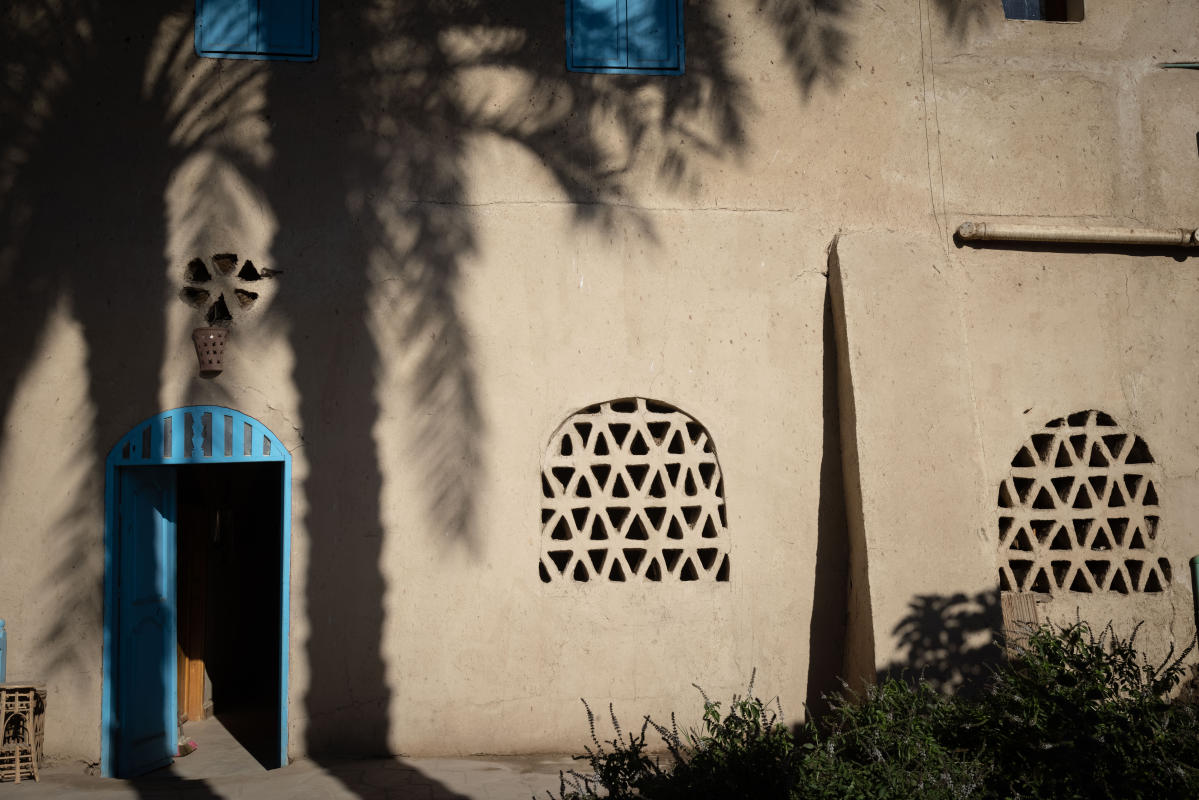From the mosque in this dusty desert village, you can see the wide terraces and austere columns of one of Egypt’s premier tourist destinations, the Temple of Hatshepsut, baking far in the distance. It’s late August, and by noon the temperature is already 103 degrees Fahrenheit and heading well north of that, enough to drive even the most intrepid tourists who visit the site back to their motor coaches and hotels.
But here in New Gourna there are no tourists, even though this village, placed on the World Monuments Fund watch list in 2010, may be as important to the future of our warming planet as the tombs and temples of Ancient Egypt are to the past. It was here that the Egyptian architect Hassan Fathy began a social housing experiment in 1945, planning a town with traditional Nubian materials and design, defended against the heat with thick walls of mud brick and natural ventilation – passive cooling techniques that had, for millennia, been an essential part of the local architecture.
Fathy, a progressive architect with a deep respect for the past, broke with the dogmas of modernism, the generic boxes of concrete and steel, plugged into the electrical grid, that had become a universal symbol of Western progress around the globe. He was interested in something more radical, and better suited to Egypt: sustainable architecture, built by hand by local artisans and designed to be habitable even during the hottest days of the year.
I’ve come here to find what remains of Fathy’s experiment on the Nile in Upper Egypt, some 400 miles south of Cairo. It’s one stop on a longer trip to some of the hottest places on the planet, to see if the three basic elements of passive cooling – earth, water and wind – really function as Fathy and other architects say they do. Do the thick, earthen walls that Fathy built in New Gourna really keep a house cool? Can a fountain splashing in an Ottoman courtyard drop the temperature to bearable levels? Can desert winds be harnessed from above a house to wick the sweat off those inside it?
From the comfort of libraries in a much cooler climate, I had read about these buildings and the punishing climate they withstand. But when I visited them, it was my body, not my mind, that registered the magic of their design.
Passing under a soaring air shaft of a Cairo mosque, it felt like someone turned on the air conditioning. In New Gourna, I entered the darkened shelter of a simple mud-brick room and I imagined I was stepping out of a sauna, into a flood of cool, dry air. In a city in the arid zone of eastern Turkey, I watched the attendant of an old courtyard house water down the porous stone of its leafy, green courtyard, and the seasons seemed to change, from high summer outside to a burst of spring within.
All of these technologies have their contemporary equivalents: Electric fans, swamp coolers and insulation. But throughout the Earth’s hot zones, many of them in the Global South, the new technologies are expensive, and create dependence on erratic electrical grids and networks of production, commerce and transportation that are alien, and unsustainable.
The old technologies are also a resource: They offer a way forward, architecturally, culturally and climatically, not just for torrid zones in Egypt or Turkey, but for heavily populated regions throughout the world that rely on precarious sources of power. From Cairo to California, there are architects who are already incorporating these technologies in contemporary buildings. But there are multiple challenges: overcoming skepticism among people long dependent on modern systems, recalibrating what it means and feels like to be comfortable, and recovering and preserving the wisdom of vernacular systems.
The last of these challenges – undoing erasure and forgetting – is urgent. The few remaining houses from Fathy’s original plan are crumbling in New Gourna. In the searingly hot Kurdish city of Diyarbakir, in southeast Turkey, civil unrest and oppression has led to whole swaths of the ancient town, full of historic stone homes with complex fountain systems, being demolished. And in Cairo – where some of the world’s most sophisticated passively cooled houses were built centuries ago – decay, neglect and government sponsored demolition threaten to erase invaluable heritage.
“We already figured out how to coexist with the warm climate,” says Khaled Tarabieh, university architect and professor at the American University in Cairo, with a sense of exasperation. As he teaches a new generation of architects, many of whom are keenly aware of the climate crisis, he faces a double challenge. How can he and his colleagues not just preserve the traditional wisdom of vernacular architecture, but make it attractive to profit-driven developers, and clients who often look to the energy-hungry designs popular in wealthy entrepots like Dubai?
For an architecture critic, it doesn’t seem like this should be such an uphill battle: The traditional architecture that is being ignored or erased throughout the world’s hot zone isn’t just functional, sustainable and uniquely local, it is beautiful.
But nothing, of course, is ever that easy.
Earth
Hassan Fathy found that out the hard way. Born in 1900 in Alexandria, Egypt, he enjoyed a life of privilege and was, throughout his career, cosmopolitan in his leanings. He was alert to the emerging international modernist styles, was aware of the heavy-handed utopian aspirations of architects like Le Corbusier, admired the clean lines of modernist styles in Europe and understood the necessity for architects to address broader social problems. Yet, the modernist fetish for walls of glass and fixed shading devices – brise soleils – made no sense in Egypt, which needed its own accommodation between the past and present.
When asked by the government to design a new village for workers displaced from a sensitive archaeological site now known as old Gourna, he struggled with the complex and punishing economics of housing large numbers of poor people using contemporary construction methods.
“There is no factory on earth that can produce houses these villagers can afford,” he wrote, in a 1969 book called “Architecture for the Poor.” Steel and concrete were expensive, but mud brick wasn’t just affordable, it was effective at keeping houses cool. Fathy thus began an intensive study of Nubian architecture including ventilation, the thermal properties of different materials, window placement and the use of courtyards to keep houses cool.
Even late in the morning, the courtyard of Fekri Hassan’s house in New Gourna is shady and comfortable. Hassan, a distinguished geoarchaeologist who has taught at Washington State University and University College London, has created a center for sustainable architecture in Gourna and is determined to preserve the remains of Fathy’s village. Over several cups of strong, dark and sweet tea, he explains how a Fathy house works. Bricks can be made of mud, baked in the sun rather than energy-intensive kilns. They are cheap to produce, relatively weak structurally and very inefficient at conducting heat. But when built up into thick walls, they are strong, stable and trap cool air inside for long stretches of the day. He shows me a bedroom with a twin bed set into a thick, arched alcove and a rugged but graceful dome of mud brick above. Outside, the sun is withering; inside, the light is low and it feels a bit cavelike, but the bed is cool and inviting.
A corridor leading from the courtyard – now full of pictures of New Gourna over the long arc of its construction and decay – creates a palpable breeze through the house. Stairs lead to the roof, where people would sleep at night while the mud house below slowly cooled in the night air. A curious pattern of angled bricks along the rooftop parapets helps create a faster flow of air above where people would sleep. From the roof, you can see modern structures rising nearby, with metal rebar sticking out like weeds atop the concrete structure – an indication that the owners want to add more floors.
“The owner of that one,” says Hassan, “has a permit for demolition.” He is pointing to the remains of one of Fathy’s original houses, dwarfed by the newer structures.
He takes me to the town mosque – one of Fathy’s most earthy but elegant designs – which has been restored by the government as a heritage site, and the same principles are in operation. A lush courtyard garden offers shade and evaporative cooling, creating air flow to the main sanctuary, a tall, domed space where the heat gathering above your head is vented out. Now, well after noon, it is unbearable to stand in the open sun, but in the mosque, it feels like the clock stopped around 8 a.m., when the air was dry, cool and fresh.
As the sun continues its relentless assault, we pass through the town, visiting Fathy’s own house, which is being restored after a partial collapse. It is a sad reminder that New Gourna was both a landmark project, and a failure. The workers who were supposed to move here didn’t want to leave their old homes, closer to the ancient sites, like Hatshepsut’s temple, that were the source of their illicit income from looting. New Gourna was never finished, and only partially occupied, and today all the things Fathy opposed – cheap, unsustainable, generic modern design ideas – are encroaching on the few relics of the original town.
“I think he would lament that we have not done what we should have done when he made his experiment in the 40s,” says Hassan. That includes learning from the past, building with the least impact on the world, and respecting the lessons of traditional architecture, including its technologies for cooling. “His message is as cogent and urgent as ever, even more so now,” says Hassan.
Water
Courtyards, like the small one in Hassan’s house in New Gourna, are essential to cooling buildings throughout the region, and they come in many different forms. In urban dwellings, they can be compact and vertical, venting out heat during the day and storing cool air gathered at night. But I was particularly interested in the grand, open courtyards of Ottoman-era houses in Eastern Turkey, where the weather is just as brutal in the summer as Upper Egypt. These courtyards, which use pools, fountains and trees to create garden-like microclimates, are part of a complex system of cooling dependent on water, vapor and evaporation.
Many of the most sophisticated examples of this kind of architecture are in Iran, where it isn’t easy to travel. So I opted instead to go to Diyarbakir, a mostly Kurdish city more than 600 miles east of Istanbul, where a few examples still exist. The courtyard houses of Diyarbakir have also been studied intensively by local architects and historians for their passive cooling technology.
I had only a short time there, so I hired a local guide who knew the troubled politics of her city intimately, but less about the complexity of the local building style and why it is of such interest in the age of climate change. Political oppression from the central Turkish government has forced some of her family into exile, and she’s curious and slightly amused that I have come to her city not to report on politics and unrest but to look at buildings. But she’s disgusted, and says so in salty language, by the losses to local architectural heritage.
After a day’s walk through the narrow, crowded streets of the walled town, which sits on a bluff above the Tigris River, we found many of the old methods of cooling these historic structures intact, but none of them entirely operational. At the 18th-century house of the famous poet Cahit Sitki Taranci, now a museum, the courtyard was paved with porous stone – which absorbs water like a sponge and then releases it through evaporation, thus cooling the space. But the central pool was more ornamental than functional. And in the meticulously restored 19th-century Cemil Pasa mansion, now a museum dedicated to the history and culture of Diyarbakir, the fountain was running, but the rooms nearby had been enclosed and were artificially air-conditioned.
But at a modest cafe in the old town I got access to the L-shaped remains of what was once a four-sided traditional courtyard house. The magnificent summer “iwan,” a high-arched enclosure on the southern wall, was still extant. It opened to the north, offering deep shade, and just outside its entrance was a functioning fountain.
Guests at the Iskender Pasa cafe crowded the tables near the fountain – a square-shaped pool with a lazy jet of water – where the shade and evaporative cooling dropped the temperature to what one might expect on a mild, early autumn day. I asked the waiters if there was a “serdab,” the coolest room in a traditional Diyarbakir house, and they looked confused. But after a little explanation, they pointed to a side room, just off the iwan.
And yes, there it was, a small semi-subterranean space with the remains of a pool fed by water channels. A small window facing the courtyard vented heat, and there were the remains of an old fountain now disused and dry. Ayhan Bekleyen, a professor at Dicle University in Diyarbakir, says that people traditionally spent the hottest hours of the day in the small, enclosed but remarkably cool serdap.
“Since there were no refrigerators in the old times, fruits such as watermelons were [also] cooled by keeping them in the small pool below the fountain,” he added, in an email.
Bekleyen’s study of these houses has revealed other key elements. Just as in New Gourna, residents often moved to the roof level during the evening, while the stone walls of the house cooled down. But throughout the year, they also moved horizontally through the house, from summer rooms that faced north to avoid the sun’s heat to winter rooms that faced south, to absorb it.
Scholars have also studied the relative comfort level of houses built throughout the region. One analysis, in the city of Mardin some 60 miles southeast of Diyarbakir, compared a 17th-century home (with stone walls more than about a meter thick) with a modern concrete and brick structure built after 1990. Not only did the traditional house stay cooler and more thermally stable during the hottest part of the day, but the residents of similar houses had strikingly different perceptions of comfort. More than two-thirds of those who lived in traditional houses reported feeling comfortable, while almost 70 percent of those in modern, boxlike structures felt the opposite: It was hot.
The psychological aspect of cooling isn’t to be discounted. The sound of water and the transition from bright sun to cool shade in the iwan are essential to the larger cooling effect. That made me particularly interested in finding a selsebil, a type of fountain that created miniature waterfalls. But if they exist in Diyarbakir, no one seems to know where they are.
That loss is part of a larger, more disturbing destruction of heritage: The wholesale demolition of large parts of the city after clashes between government forces and the local Kurdish population in 2015 and 2016. During our walk, we passed suddenly from the streets near the bustling central market to a moonscape of devastation, open fields, rubble and scrubby grass. A few, newly constructed homes inhabited this alien landscape like generic condos in any faceless suburb on the planet. It was both a political and a thermal journey: From a living, Kurdish city to a modern, dead one, from narrow, shady streets to the withering full blast of the midday sun.
“He f— us over,” said one of the women I was with, referring to Turkish President Recep Tayyip Erdogan.
A few crumbling remnants of centuries-old walls still hung in the air, memorials to what has been lost. No one knew their exact origins, but before the demolition, the thick stones at their base probably never felt the direct rays of the sun. The cool mass near street level, now surrounded by rubbish, would have absorbed heat from the air, offering respite to passersby. But that function is lost now, like untold numbers of historic structures that once filled this desolate space.
Wind
Meteorological data suggest that Cairo is not a particularly windy city, yet I have never been so keenly aware of how breezes move through urban space. As I walked through the ancient neighborhoods of old Cairo, it seemed the air was always in motion. And when the temperature is over 100 degrees, dry, moving air is a lifesaver.
I came to Cairo in search a functioning malqaf, or windcatcher, a passive cooling device that dates back to ancient Egypt. They were once omnipresent throughout the region, and their distinctive profile – like a rooftop stairwell angled toward the prevailing winds – can be seen in seen in 19th century photographic surveys and in the magnificent engravings of Egypt collected in the Napoleonic-era “Description de l’Egypte.”
Now, not so much. I found a few, including one that functioned, atop historic houses not far from the giant Al-Azhar Mosque in the center of the old Islamic city of Cairo. A small tip, or baksheesh, given to the guard at the 17th-century Wasila House got me access to the rooftop, where the malqaf draws air into a chimney-like air shaft. Far below, where the vertical column vents into a large ceremonial room, I could feel a faint breeze.
In the most sophisticated and wealthy houses of Cairo, the malqaf was part of an integrated system of wind, water and earth designed to keep spaces cool. Breezes from the windcatcher circulated air around fountains and pools; windows covered by intricate mashrabiya, elaborately carved wooden screens, allowed air to circulate while keeping out the heat of the sun; vented cupolas allowed heat to rise and escape while tall, narrow courtyards collected and maintained heavy, cool air well into the hottest hours of the day.
I wanted to see – and feel – all of these technologies working in concert, but that proved impossible. The closest I came was at a historic site known as the House of Suhaymi, a sumptuous mansion near the center of old Cairo. There was majestic summer reception hall, with an elaborate carved fountain, a windcatcher, a tall, shaded courtyard and windows covered with mashrabiya screens. There was also an elevated room with windows on both sides, facing both a cool inner courtyard and a sun-drenched outer garden, with an extant, animal-powered wheel for pumping water. I could feel a refreshing draft between the courtyard and garden, probably another intentional passive-cooling design that uses the temperature differential between hot and cold spaces to create air circulation.
It was all there, except none of the pieces were connected. The fountain was covered with plexiglass, perhaps to protect its delicate stone carving, and many of the windows were closed. It was as if someone had assembled a perfectly designed machine, but failed to plug it in.
The House of Suhaymi is now a museum and it is designed to tell stories about the wealth of its former owners and how they negotiated privacy in a society that had strict protocols around gender. No one is foregrounding the even more interesting story of how it stayed cool and kept its inhabitants comfortable, even while Egypt, last summer, suffered multiple blackouts as the government dealt with a chronic lack of power for the electrical grid.
Today, we could call the House of Suhaymi a well-insulated home with passive, downdraft cooling, complex solar shading and brise soleil, and it would probably get a gold rating according to the prevailing environmental design standards in developed countries (according to one academic study of its performance).
Meanwhile, in Cairo, millions of air conditioners churn in the midday sun, people hang sheets and table clothes to shade their concrete balconies, and take the stairs to avoid being caught in elevators during a blackout. The old technologies embedded in vernacular architecture are apparently of little interest in Egypt, where Dubai often seems to be the architectural and lifestyle fantasy of the privileged and cosmopolitan. Architecture students who want to make buildings sensitive to climate change tend to look to modern, westernized green building technologies rather than their own traditions, which is frustrating to architects and teachers like Khaled Tarabieh.
“It is an architectural discourse problem,” he said, a question of how countries like Egypt think about not just climate change, but history and identity. “Where are we heading? Will we reinvent the past, living and learning from best practices?”
It’s the only path that makes sense, and he hopes architects will take it, while there is still enough of the past to teach the present how to have a future.
Related Content
Why these homes in the hottest places don’t need AC
Her story fueled anti-trans bills. Now, she’s fighting them.
Michael Bennet’s family fled the Nazis. Now, he won’t give up on Ukraine.

Dr. Sarah Adams is a scientist and science communicator who makes complex topics accessible to all. Her articles explore breakthroughs in various scientific disciplines, from space exploration to cutting-edge research.







